How to Wash Dishes While Camping
This post may contain affiliate links.
In this post we’re sharing our tips for tackling everyone’s least favorite camp chore: washing the dishes!
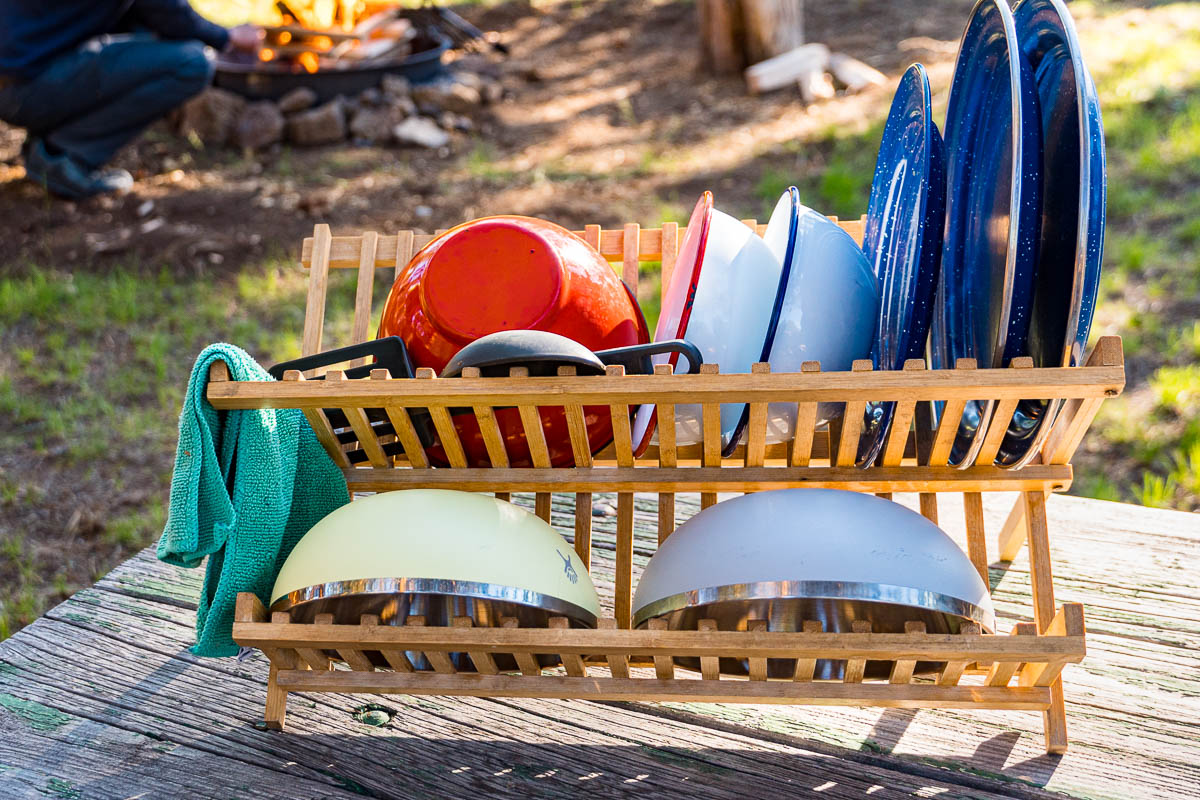
Few people enjoy washing dishes at home, never mind at a campground. With no dishwasher, sink, and limited water, washing dishes when camping can be a real challenge.
This problem is near and dear to our hearts because few people hate doing dishes more than us. And running a camp cooking blog, we have to do A LOT of them!
The key is to develop a process. While washing dishes will probably never be fun, with a good system and a few pieces of gear, it can be over in no time.
The basics of washing dishes at a campground
If you’re at a developed campground with designated dishwashing facilities and drain water basins (they will be well-marked), use them! These are rare in the US, and many campgrounds do not have them.
Resist the temptation to do your dishes in the bathroom sink or at the drinking water spigot. These areas are not designed to handle food waste and will attract animals.
As a rule, you should always be prepared to wash your own dishes at your campsite and responsibly dispose of your dishwater. Below we go through a detailed step-by-step process of how to do this.
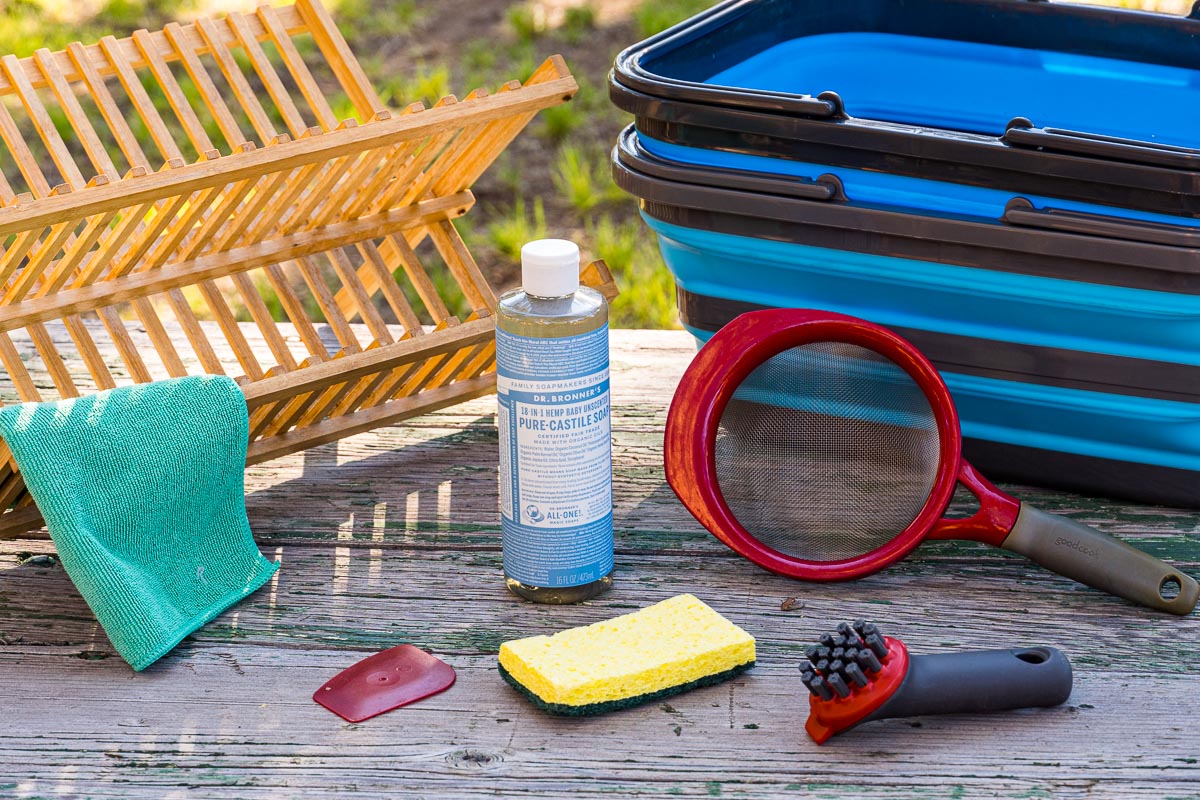
Equipment Needed To Set Up A Camping Dishwashing Station
Sinks: These can be collapsible camping sinks, plastic bins, or buckets. It doesn’t matter what they are, so long as they hold enough water and can fit your dishes. A large cook pot can also double as a “sink” in a pinch.
Pan Scraper: This little scraper is a must-have! Use it to scrape any food residue off plates, pots, and pans into the trash before washing to give yourself a head start.
Sponge or Brush: Either one will work!
Biodegradable Soap: Household dish detergent can be really harmful to the environment, so you will want to pick up some biodegradable soap instead.
Fine-Mesh Strainer: You’ll need a strainer to remove solid food waste from your dirty dishwater before disposing of it.
Clean Dish Towels / Drying Rack: To lay out your dishes to dry.
Before we begin, we want to point out that all dishes should be washed away from water sources—and never in lakes, rivers, or streams. Biodegradable soap needs the bacteria in the soil in order to properly break down. So dispose of used dishwater at least 200 feet (70 adult paces) away from any water source; otherwise, it will be just as damaging as detergent.
How To Wash Dishes While Camping (Step-By-Step)
1. Clean Plate Club
Making the right amount of food and finishing everything on your plate makes washing dishes a lot easier.
Be sure to get an accurate assessment of everyone’s hunger level before the meal so you can figure out exactly how much to cook.
Having empty resealable containers on hand to store leftovers in your cooler can also make post-meal clean-up much easier!
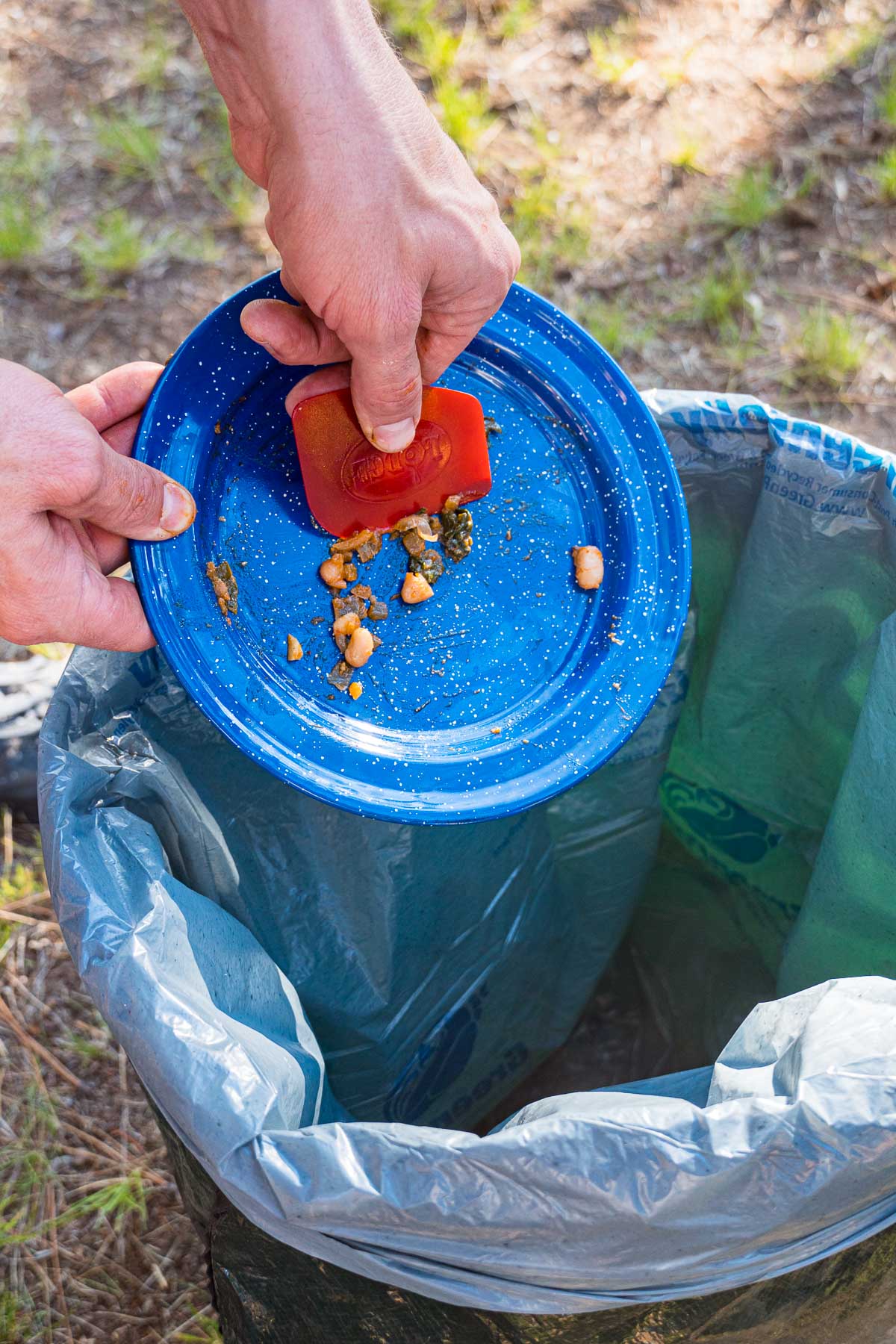
2. Prep Dishes
When you are finished with your meal, remove as much food from your dishes as possible.
The more food (and sauce) you can scrape into the garbage, the easier it will be to clean the dishes.
Using a pan scraper like this will really make this task easy! A rubber spatula will also work. In a pinch, you can use a few sacrificial paper towels.
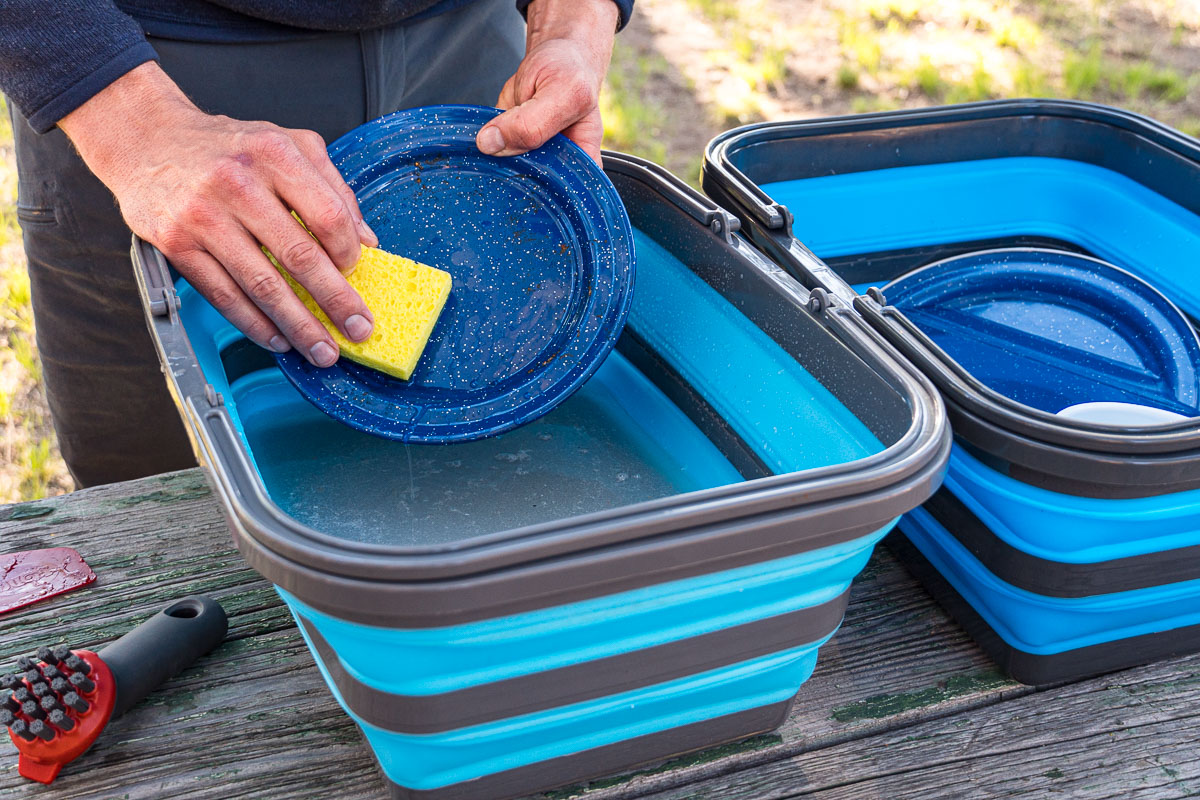
3. Wash & Rinse
This process gets your dishes and cookware as clean as possible while using the least amount of water. We use collapsible buckets, but you could also use cheap plastic bins too.
- Wash Sink: Fill this sink with warm-to-hot water and a few drops of biodegradable soap such as Dr. Bronner’s or Campsuds. Start with the cleanest dishes first and then progress to the dirtiest dishes last. Once the item is entirely clean, shake off any excess suds back into the sink, and proceed to the rinse sink.
- Rinse Sink: Fill this sink with hot water. When the dishes come out of the wash sink, they get dunked in the rinse sink water here. If the dishes aren’t quite clean or have excessive suds on them, send them back to the wash sink. After this rinse phase, the plates should be completely free of soap.
- Sanitize (Optional): A sanitizing wash may be helpful particularly if you prepared raw meat. You need scalding hot water to kill germs that can cause foodborne illness, and it’s likely that your wash & rinse buckets weren’t hot enough.
Here are two ways to sanitize your dishes:
- Use boiling hot water in your rinse bucket and let dishes soak there for at least a minute.
- Set up a third bucket that contains a sanitizing agent like Sterimine and briefly soak dishes in it before letting them dry.
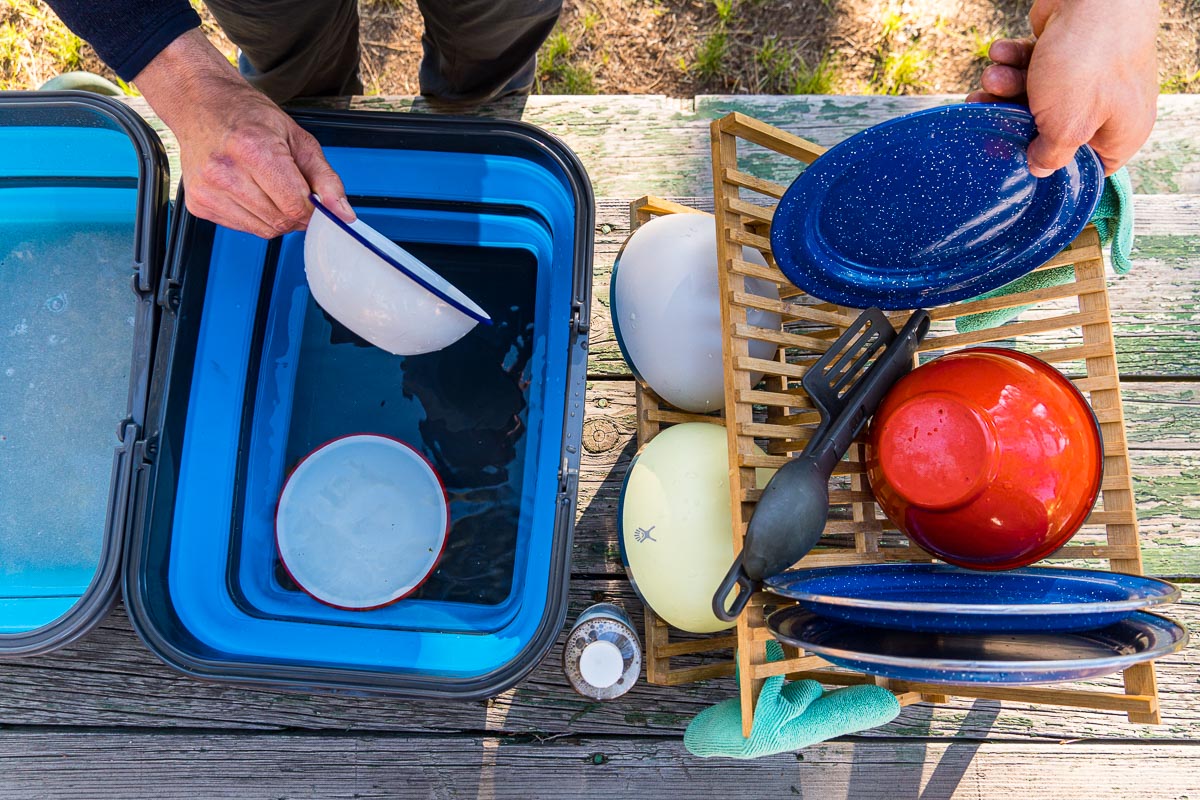
4. Dry
When the dishes come out of the final bucket, you can set them out to air-dry or hand-dry them with a clean dishcloth.
Bring a collapsible dish-drying rack to help preserve your tabletop space while everything is drying.
A note about hand drying: It’s really important that you use a clean cloth; otherwise, you risk transferring bacteria back onto your freshly cleaned dishes.
5. Search For More Dirty Dishes
When you are finished washing the last dish, double-check to make sure it was actually the last dish.
There’s nothing more annoying than finding out that somebody forgot to bring their plate over after you’ve already dumped your water and broken everything down.
Make sure you’ve gotten all the cookware, too. We’ve often cleaned everything only to realize we forgot the pot we cooked in!
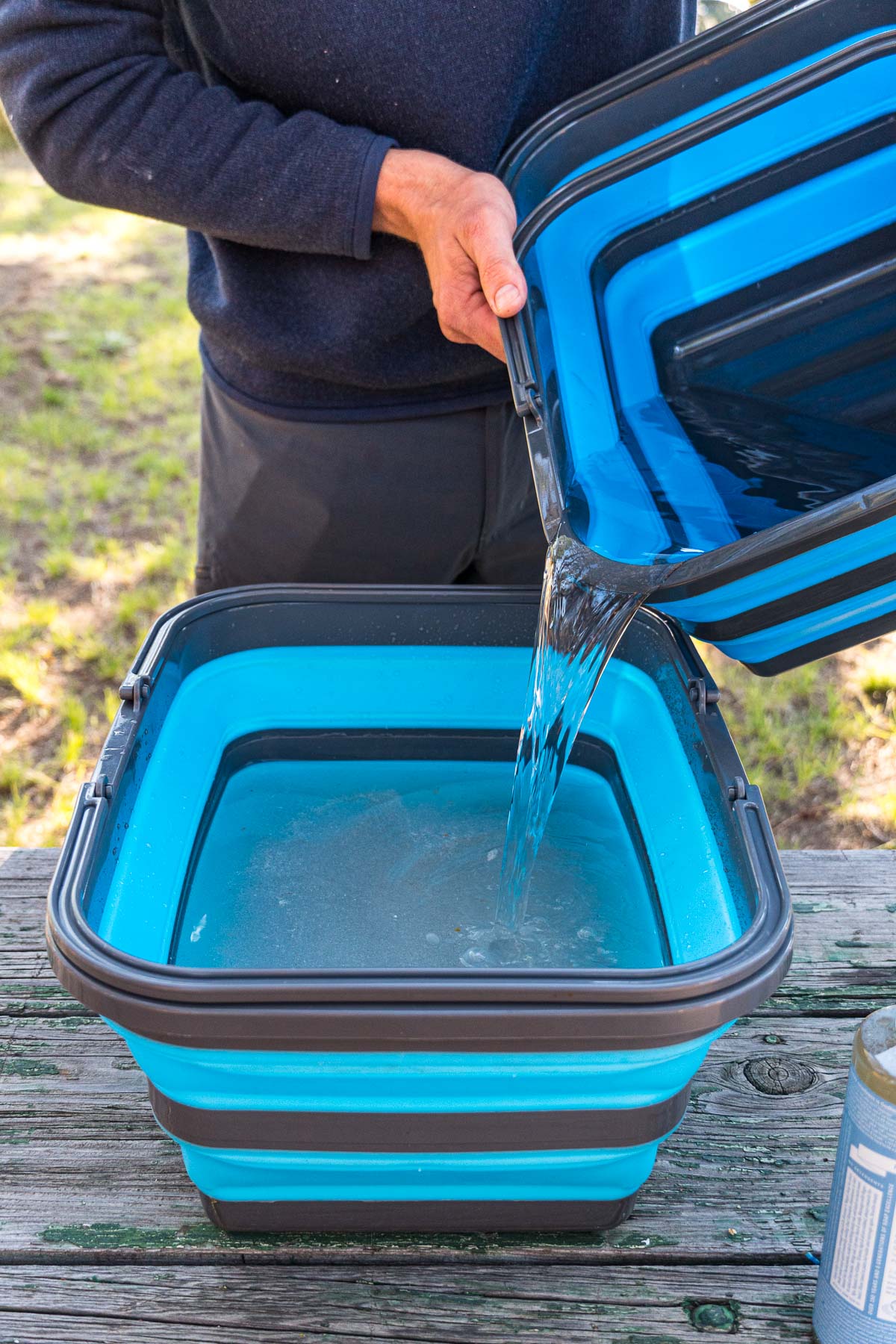
6. Consolidate Greywater
Once you’re sure there are no more dishes, it’s time to consolidate your gray water.
Dump the rinse sink into the wash sink. If you used a third sink for sanitizing, dump that into the wash sink as well.
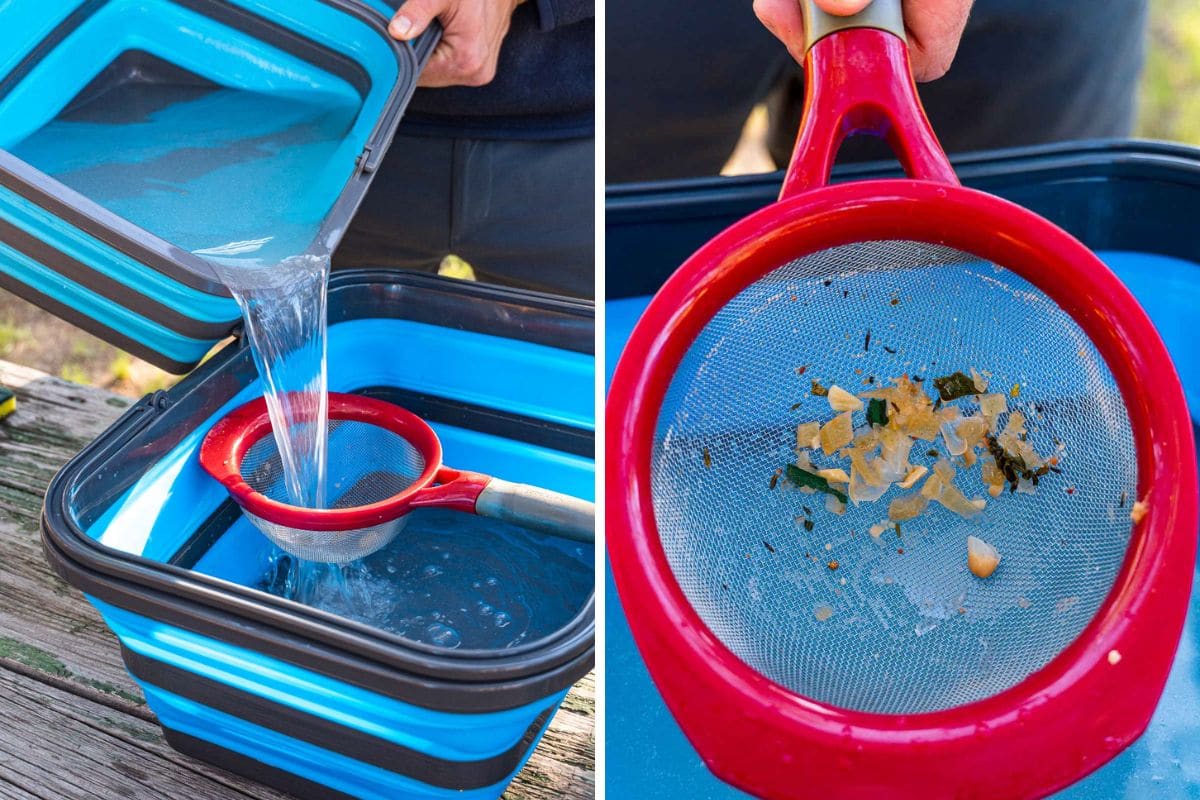
7. Strain Out Food Scraps
Place a strainer over one of the empty sinks and pour all the water through it.
This will separate out all the tiny food particles that came off during the wash.
Empty this solid waste from the strainer into your garbage.
Now you should be left with a sink with all of your greywater.
8. Dispose Of Greywater
If you’re at a campground with facilities with drain water basins (they will be well marked), use them.
If no facilities exist, check with the camp host or call the ranger station in advance to see what the proper method is.
In lieu of disposal facilities, Leave No Trace recommends disposing of greywater by broadcasting it (essentially spraying it) over a large area. This should be done at least 200 feet away from any water source.
Spreading the greywater out over a large surface area minimizes its impact on any one spot and allows it to rapidly integrate with the soil, where it can start breaking down.
You can also bury greywater in a cathole 6”-8” deep.
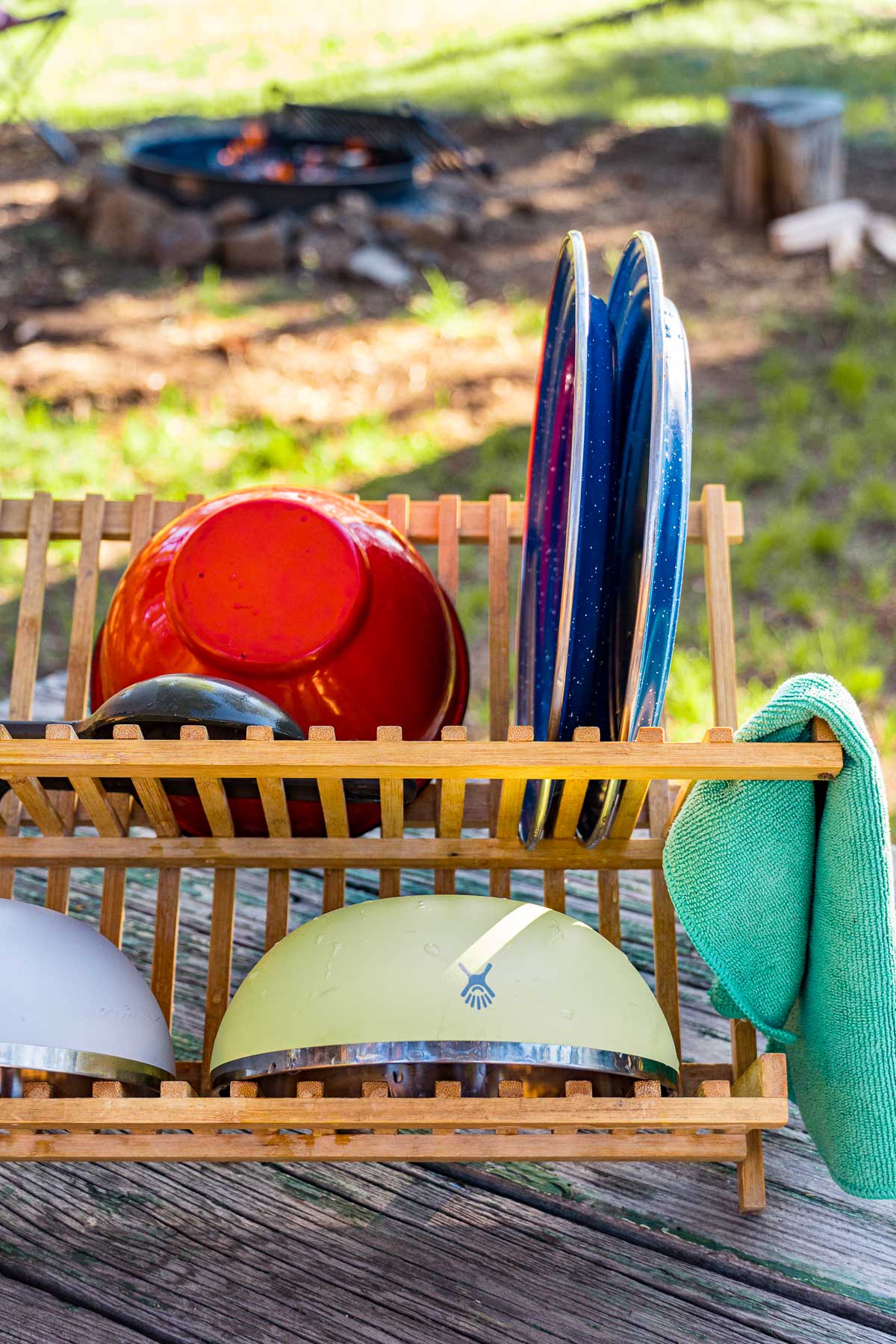
We hope this post was helpful in demystifying how to wash dishes while camping! Be sure to check out our other camping tips and how-to posts to brush up on other camping skills.

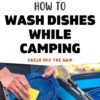

Bleach is not very effective. Use what the health department recommends, the “blue tablets”. They are not all that blue, but they kill MRSA, HIV, and everything in between in room temperature water. One tablet per gallon of water, don’t rinse, and you’re good.
Steramine Quaternary Sanitizing Tablets, about $8 for 150 tablets.
https://smile.amazon.com/gp/product/B000W09SF6/
Hi Walter,
Thanks so much for the info about Sterimine! We haven’t come across that product before, but we’ve added it to the article. It seems like it would be a really good option especially if you’re camping with a large group or a group with kids.
Really appreciate your feedback. Have a great weekend!
-Megan
I am a health inspector at a local public health department and the FDA food code allows chlorine (bleach) or quat sanitizer and both are equally effective. I recommend having test strips to check sanitizer concentrations.
Great overview! We used a similar set up for 2-weeks on the Colorado River through the Grand Canyon last year and the 3-step system is great.
Thanks! We’ve found people can have strong opinions about wash dishes. (who knew!) I guess everyone needs to find the system that works best for them (without negatively affecting the environment) Glad you approve of the 3 bucket system!
Hey there! I really love how you put together a short video showing the actual steps in your posts as I am a visual learner 🙂 I am interested to know if you use this same method for cleaning your cast iron? It can be a tough job even in the home kitchen so just wondering how you handle this in a camp kitchen. Thanks.
this is such a nice article.i did many times in the Nepal mountain.
I learned this system almost 50 years ago in Girl Scouts. Of course we didn’t have collapsible buckets or Steramine!
It’s all pretty basic stuff. But when we see people washing their pots and pans in the bathroom sink, we just don’t know what to think.
Hey, don’t think anything is too basic to share! I certainly didn’t know and am glad to know the correct process now! Many thanks!
Great technique.
For those in the UK these wash bowls are similar, just don’t have bucket handles http://www.wilko.com/search?q=collapsible+wash+bowl#
with the option of a drainer style too and all for £5!
Those look sweet! Wish we could get our hands on those!
Is the bleach rinse necessary if you are using potable water to wash and rinse the dishes? Our campground has water at each tent site.
It’s not “necessary” but it’s one way to fully disinfect. If you’re just cooking veggies, probably not a big deal. If you’re preparing raw chicken, then maybe it’s a good idea.